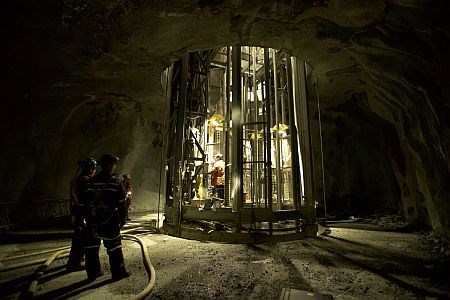Swiss mining giant Xstrata plc has seen profits slip 77 per cent through the first half of 2009 against the same period the previous year, due in part to the low price of nickel, lower volumes and rising inflation.
Xstrata, which is active in the nickel and copper camps in Sudbury and Timmins, saw profits sink to $643 million, down from $2.8 billion in the first half of 2008, according to mid-year financial reports published Aug. 4.
This is due in part to slipping revenues, which sagged 39 per cent, from $16 billion in the first half of 2008 to $9.9 billion in the first half of 2009.
"As stock markets rebound and achieve significant gains, it would be tempting to believe that the world is returning to pre-financial crisis conditions," said Xstrata CEO Mick Davis in the report.
"However, until U.S. consumers emerge from the current deep recession to resume expenditure and consumption in any meaningful way or domestic consumption in China of similar power emerges, I fear that this belief is somewhat premature. As an industry, it is important to remember that a full recovery is not yet definitively under way as we execute our plans for the future."
In particular, Xstrata Nickel's Sudbury operations produced 70 per cent less ore as compared to the first half of 2008. Production reports show that local operations' numbers dropped from 882,151 tonnes to 262,496 tonnes due to the closures of the end-of-life, high-cost Craig and Thayer-Lindsley mines, and the suspension of the Fraser Mine complex.
The impact was somewhat lessened at the Strathcona Mill, where a 51 per cent production decline was softened somewhat by custom feed and processing inventories from local mines.
Nickel operations in Timmins were similarly affected, as ground subsidence or "unplanned ground movements" at the Montcalm mine led the site to be temporarily suspended in March, and indefinitely suspended in June.
These shutdowns and "optimizations" have also led to the reduction in the the cash cost per pound of nickel, which dropped 27 per cent across all nickel operations, company officials said in a presentation to shareholders.
The price fell from an average of $5.63 in 2008 to an average of $4.09 in the first half of 2009, due in part to the shutdown of its Falcondo operation in the Dominican Republic. It is also due to the changes at its Sudbury operations, whose local unit production costs were lowered by 38 per cent.
Lower metal prices and sales volumes for copper, zinc, acid and gold hit Xstrata Copper's Canadian operations particularly hard, with operating profits dropping 152 per cent.
Timmins' Kidd Creek also mined less in the first six months of 2009 than in the same period of 2008, dropping from 1.3 million tonnes to 1.1 million.
Although figures were down across the board, the company offered up a positive outlook for commodity demand, particularly as rapidly growing markets such as China, India, Russia, Japan and South America make up a growing majority of sales.
In China, bank lending reached $675 billion through the first half of 2009, half of which was for infrastructure projects.
Sales have primarily been to the construction, infrastructure and electricity generation sectors, "all of which are set to continue to expand, boosted by stimulus packages weighted heavily towards these sectors," said Davis.
With this in mind, Xstrata is not shying away from spending, with a global pipeline of growth projects representing a potential capital expenditure of $40 billion.
This includes the Sudbury-based Nickel Rim project, which is due to ramp up to 60 per cent of its anticipated daily production as early as late 2009, with full production to be achieved in early 2010. The project's first $517-million phase has already been completed, with the current $270-million phase due to be completed by the end of the first quarter of 2010.
The Fraser-Morgan mine, currently on care and maintenance, also represents a "significant further growth option."
Davis also used the bi-annual report to continue pitching a $44-billion merger of equals with Anglo American, which he said would allow Xstrata to "compete more effectively with our larger peers including BHP Billiton, Rio Tinto and Vale." The company's largest shareholder at 34.5 per cent, Glencore International AG, is said to support the move.
www.xstrata.com




